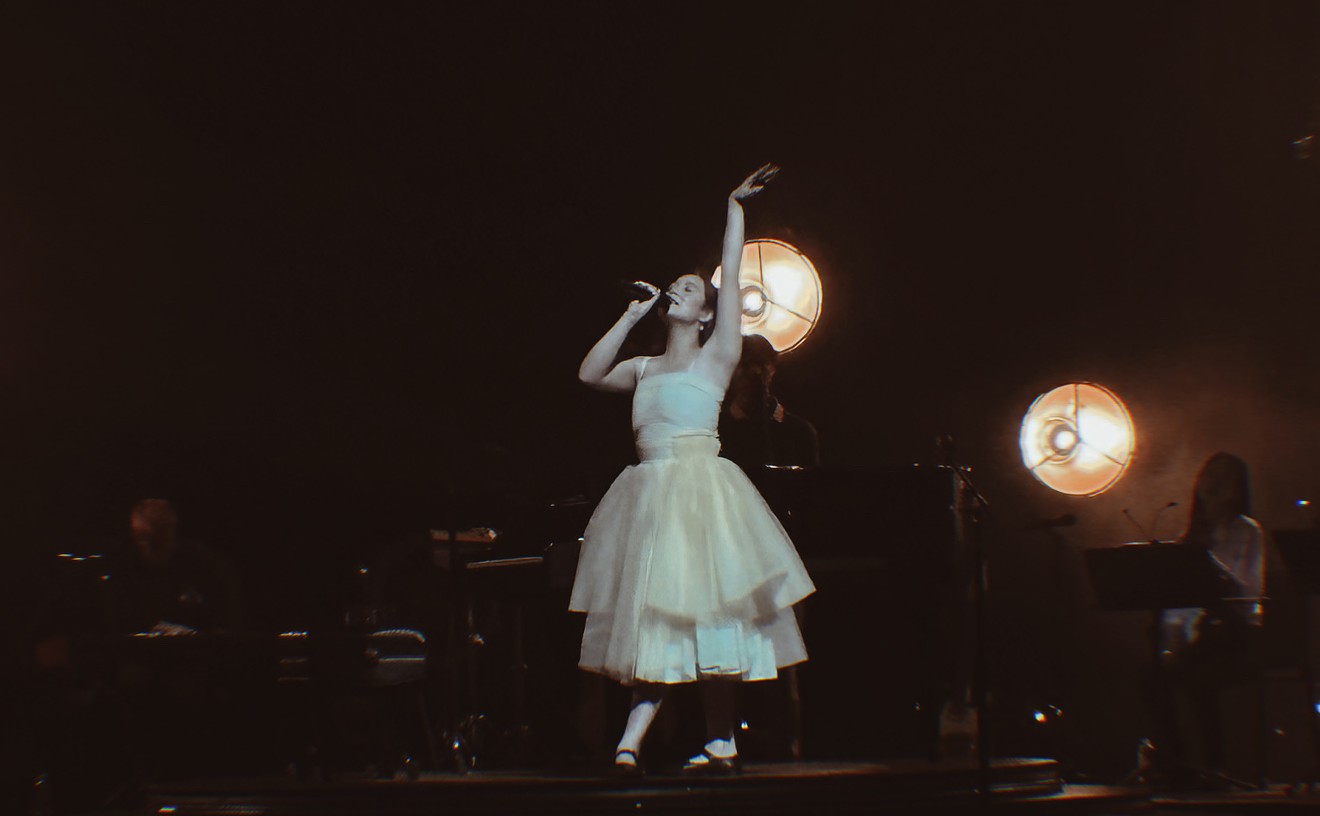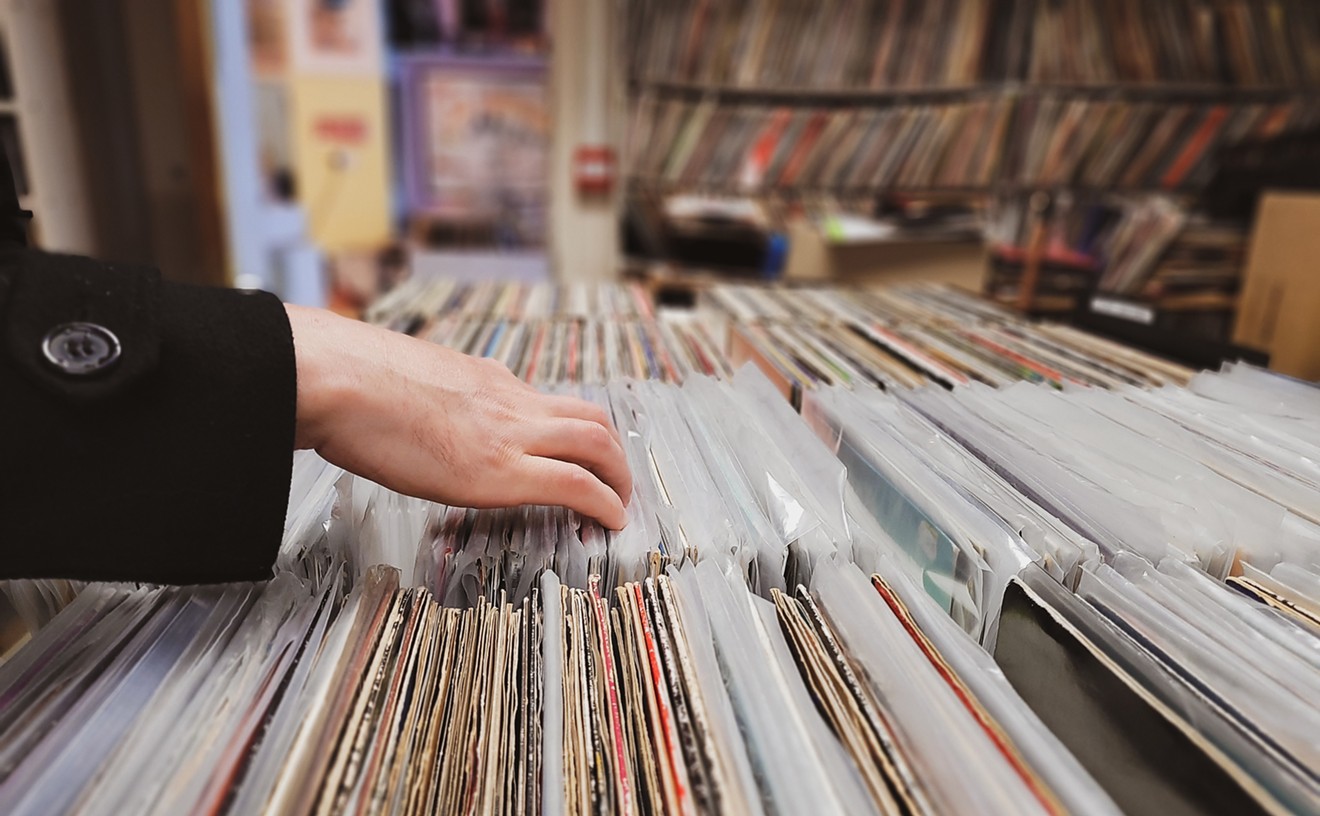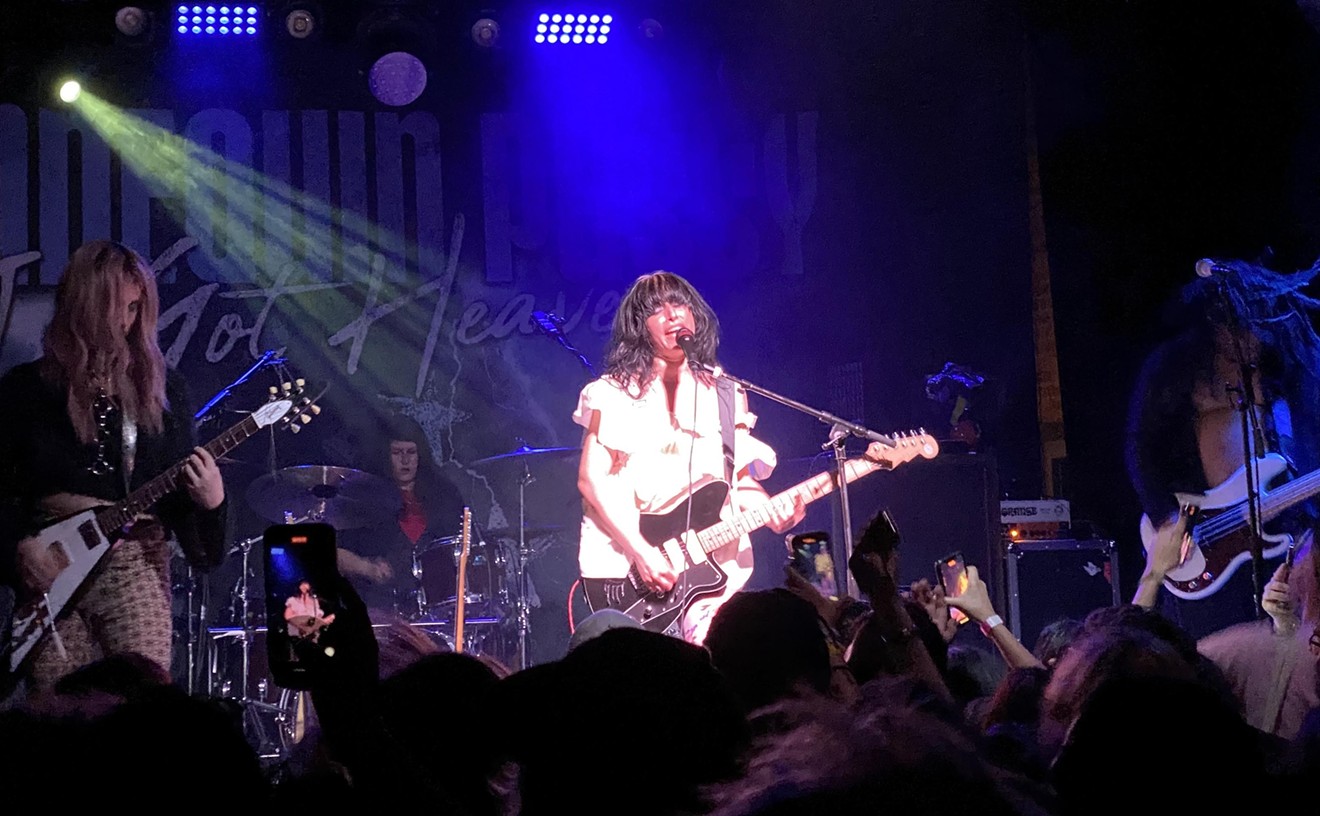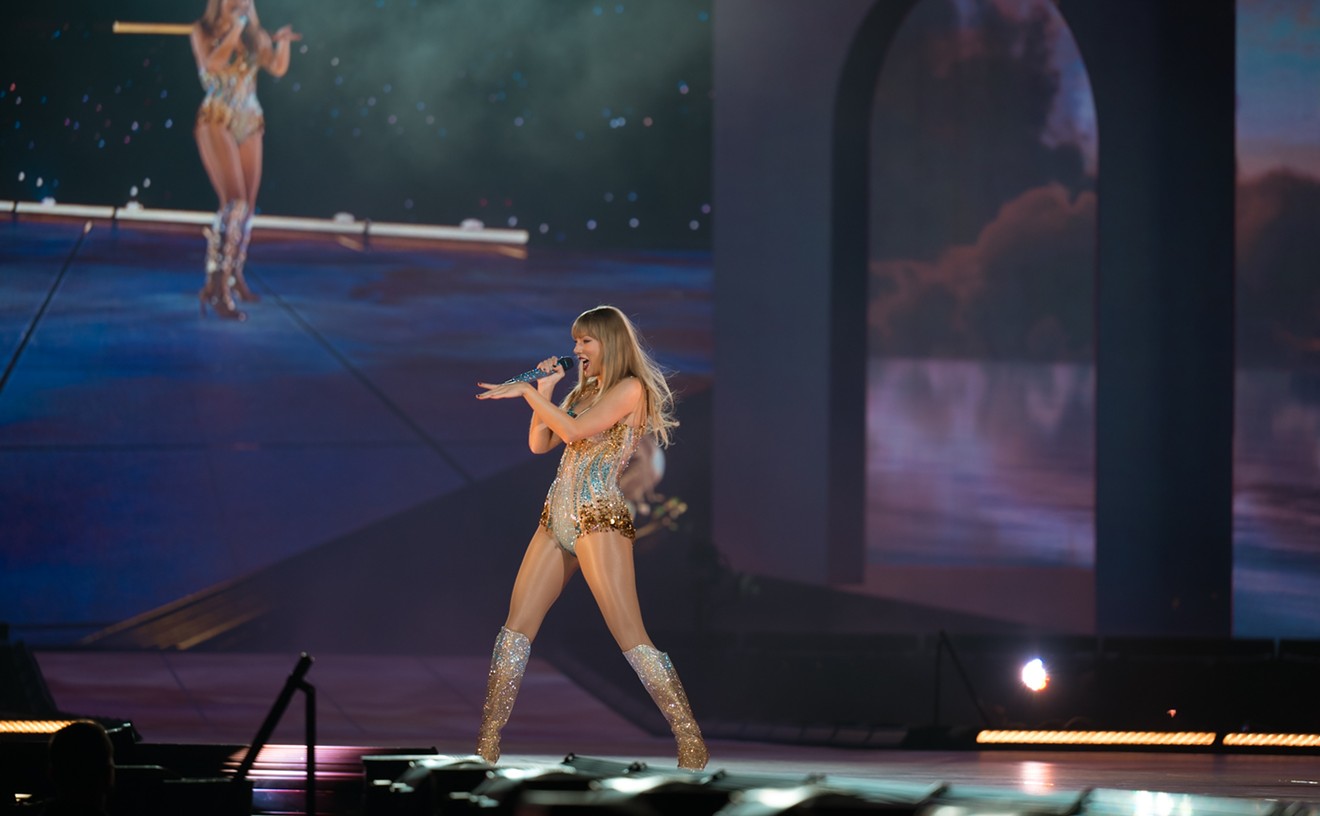Even if the name Justin Bua doesn't ring a bell, chances are you've seen New York City-raised artist's work--most notably, his almost ever-present piece "The DJ." It's the image on which Bua made his name as a prominently hip-hop-centric artist, leading the way to his design work in recent years with entities like MTV and video game company EA Sports and, even more recently, as a professor at the University of Southern California.
Starting tomorrow and running through the end of August, 10 oiriginal pieces of Bua's work will be on display at the 4th Wall Gallery on Fairmount Street, where it's also available for purchase. And, for a special treat, during tomorrow night's opening reception, Bua will be on hand from 7 to 10 p.m. to mingle with fans, admirers and curious onlookers.
Yesterday, we caught up with Bua over the phone to discuss his personal upbringing, how it's affected his art and how his lifelong interests in hip-hop and breakddancing further cemented his artistic vision.
After the jump, you can read the entirety of our discussion.
What was it like growing up in New York's West Side?
It was a
very tumultuous time. It was during the '70s. It was during
Reaganomics, and there was a lot of political, economic upheaval. There
were the blackouts in '77, the fires, the riots, a lot of instability
in the country, but I think it was a microcosm of what was going on in
the country, in my city of New York. I lived through that time, I
remember vividly and distinctly the blackouts and how it adamantly
exemplified that some people--there were people who had, and people who
were had-nots. There were people who didn't have a lot of money and you
could see it. There was more homelessness and destitution in the city.
More unemployment. More people who were middle class, but were on
welfare and on food stamps. So you had these proud New Yorkers who were
all of a sudden turning to federal assistance. [And] Reagan had shut
down a lot of the mental facilities and kicked a lot of homeless people
out of the institutions, off their medication and on to the street.
There were two welfare hotels on my block and over 200 in my
neighborhood... People who are drug dealers, pimps and prostitutes,
hustlers, junkies and even murderers... It was fun.
What was it like in that environment, being exposed to it?
When
you grow up in it, it's hard to see what you're experiencing unless you
have some kind of hindsight. For me, because of that, it was normal. It
was just really normal. Those were my neighbors, those were my family.
I was a latchkey kid with a single Mom--my mom spent most of time
hustling, not hustling on the street, but hustling making money. So I
spent a lot of time on the street and kind of hung out with these
people. They were kind of like my family. Some people were good and I
kind of learned how to get out of that moment for a second. It became a
point of reference for me that you can't judge anybody because of their
circumstances because things are circumstantial. Even though they might
have been thieves or criminals on one level, some of them are very good
and honest people on another level. Which shows you how complicated
people really are.
How have those experiences influence your art?
Those are the people in my world. Those are the characters in my
surroundings. I think that, as an artist, you have to have a visual
Rolodex of your life experience that comes out when you paint or draw.
These are the characters. I always say that these people are not
necessarily real people but are real interpretations of people who live
in my mind and now forever live in the world of my imagination. So many
really interesting people from so many different places--Cubans, Puerto
Ricans, blacks, whites, Jews, y'know, everybody. These faces will
stay with me forever. And just some of the most interesting faces I've
ever seen in my life, they still stay with me.
Which ones?
You know, everybody really. The people on the street particularly. The
guy who was playing shells to the guys playing dominoes to the pimps. I
bought my cat from a pimp, sold it to us for five dollars. My next door
neighbor, same guy that got chased the next week out of the apartment
with a rake, hit the ground, he died. These are the characters in my
world. Because of that it allows us to be creative. I think creativity
often times is spurred in times chaos. And I think it was a very
chaotic environment. It had a lawlessness. Because of the lawlessness
that's where real hip hop came from, from no rules.
You went to a music and performing arts high school?
Yes.
Do you have an artistic family?
I came from an autistic family, not an artistic family. No, I'm
kidding. I come from an artistic family. My mom was a painter--successful. My grandfather was a sculptor and a painter and he was also
a famous letterer. He did the lettering for Felix the Cat and a lot of
the old school comic books. I think that inspired me to write graffiti.
He had a really weird natural affinity for lettering and writing art.
Because of my experience with them, I had access to a lot of
interesting painters on my wall... but particularly the eastern European
artists but because that's who they loved. Of course, on the street were
all the beautiful murals on my neighborhood. I had an interesting meld
of subway car art and classical art. I think ultimately my work is
really defined by both cultures.
When did you start taking an interest in the hip-hop scene?
You know, the first time I saw breaking and popping, I think it was so
magical to me. I didn't know what it was, but I had to be a part of it.
Breaking and Popping?
Have you ever seen Electric Boogaloo?
No.
How old are you?
Do you want to know?
Yes.
I'm 21.
Are you watching So You Think You Can Dance?
If my roommates have it on, I might watch a few minutes. But you meant the dancing stuff?
Yeah, yeah. The first time I saw [breaking and popping], it was magical to me.
What was magical about it?
It was beautiful, just something I knew I had to be a part of. It
was phenomenal. It was like, "Damn, this is something I have to be a
part of."
So are you an excellent dancer?
Yeah, I was a pro dancer for 14 years. I do salsa and samba now. I still dance. I still dance.
And you toured with a break dancing crew?
Yeah, a lot. Magnificent Force, Dynamic Break group, New York Express--I toured with a lot of different groups. I can still get down.
How did touring with a break dancing crew shape who you are? Your art?
You can imagine that a 14-year-old kid is on the road--a kid from the
inner city is on the road--all of a sudden in Europe dancing in opera
houses and all of these amazing places and I had no exposure to those
kind of cultures. It exposed me to different a world. The popularity I
was getting, too. I was on CBS Morning News, Good Morning America, it was,
like, crazy.
Was this during your summer vacation?
No, that's why I got [held] back every year because I was always on tour.
I was an outstanding student, but I was out standing in the hallway
most of the time, unfortunately.
And now you're an art professor now at University of Southern California?
Yep.
What kind of a professor are you?
I teach classical figure drawing--the nude models
Oh, that's everybody's favorite class, right?
Oooh yeah. Nah, sometimes. It depends on the model. But yes, it's really cool. It's a real fun class.
Do you run a pretty tight ship or are you laid back in the classroom?
I can be both. I put the hammer down. I put the smack down when I have
to. USC could be an acronym for University of Spoiled Children, so I
like to make sure people work. I don't look at the talent level they're
at, I look at the growth. Where were you on Day One? And where are you
on the last day of class? Where are you going? Not, where you're at.
What do you do to inspire your students?
I'm just real. I'm authentic. A lot of the professors--from what
they've told me--a lot of people aren't classically trained. I give
them life experience. I tell them, 'Oh, when I was working with Nike..."
or "When I was doing this piece for Hewlett-Packard" or whatever the
project is. I give them real life experience and I think they value
that.
How does your classroom differ from when you were at art school?
I went to Art Center--it's the "Harvard" of art schools. I went to
school with people who are really talented and really practice what
they teach. I learn by trial and error and by following, and I teach
the same way.
What projects are you working on now?
I'm doing the gallery show here, I'm doing another television project
that I can't really discuss--top secret--and I'm doing a bunch of
licensing deals. I'm doing a lot of stuff.
What's been your favorite project?
Oh man, just my own stuff. Just my limited edition collections and my
posters. Just doing what I love to do which is painting. I'm actually
doing a book on the legends of hip-hop, my second book. Painting all
the legends of the hip-hop culture from Grandmaster Flash, Jay Z,
Biggie, Tupac.
Do you get to meet all the artists you paint?
Yeah, I meet a lot of people. A lot of celebrities, underground celebrities. I'm a people person; I like to kick it with people.
You met former President Clinton a few years ago?
Yeah, yeah, yeah. He's a fan.
What was that like?
It was kind of like how all the girls say that when you meet him, you
want to have sex with him. That's how I felt. It was a little weird
because I'm not gay. So I don't know. He's got a charm to him,
obviously. He's got a charisma. I'm standing in line with 18-year-old
girls and 80-year-old women and they're like, "I want to have sex with
him," and I'm like, "I do too."
And now you have a daughter.
Yeah, she's four. And she gorgeous, she's sweet and she's funny.
Do you let her paint on the walls?
No, but she comes to my studio and paints all the time. Her name is Akira.
It's Japanese. My ex-wife was Japanese. It means the energy that runs
through all things. It also means worrier and also means princess.
Does she give you a lot of energy for your art?
Definitely, except when she's trying to play fight with me. But it's fun.
The 4th Wall Gallery will run the works of Justin Bua through August 31.










